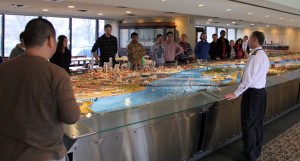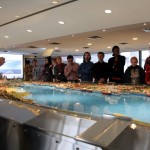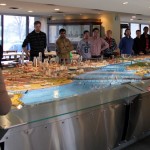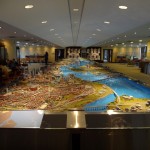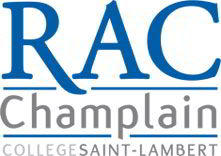A Unique Learning Experience at the Port of Montreal
by Matt Refghi | February 5, 2013
For the second consecutive year, RAC candidates and Champlain students studying towards their Transportation and Logistics AECs have participated in a unique set of classes held at the Port of Montreal. The initiative was the brainchild of Yves Gilson, Director of Communications at the Port, and Peter Raimondo, logistics instructor at Champlain College Saint-Lambert. Held on November 5th and 6th 2012, the classes featured presentations by representatives of the Port of Montreal and many of its partners, as well as executives from the transportation community. The event also included an exclusive bus tour of the Port, and an industrial tour of Lantic Sugar (situated on the Port’s property).
The presentations formed a comprehensive profile of the Port through a variety of topics, and helped clarify how it interacted with other parties. Tony Boemi, Vice President of Growth and Development, kicked off the event by speaking about the challenges of receiving global traffic and the effectiveness of moving merchandise through the port of Montreal – whether by rail, truck, or by ship.
Stefan Routhier, Deputy Harbour Master, and Stéphane Brabant explained the operations and rail services on the Port property by using a fascinating miniature model of an impressive scale. Routier also described an ongoing effort to build special access ramps to Autoroute 25, an initiative designed to reduce local traffic while reducing lost time. He also discussed past initiatives that were proven successful, such as a finger-print based authentication system that allowed truckers to get verified faster than before.
The Port’s Director of Security highlighted the various procedures utilized by the Port, such as the use of tracking devices in containers. These devices, he explained, were useful beyond their immediate security benefits – they also allowed the Port to track movement patterns, and in turn, opportunities to improve. To cover their 78 acres of immediate territory and that of their connected terminals, the Port uses fencing and more than 250 cameras to monitor areas in real-time. The Port also has its own onsite security personnel, fire unit, and HAZMAT response team, and is able to resolve most problems that occur within its own territory. For everything else, they utilize and cooperate with the Montreal Police and Fire departments. To ensure 24/7 availability of its services, the Port’s control center and core services feature multiple layers of automatic fail-safes that allow it to remain operational even in the presence of multiple malfunctions. The Director’s presentation served as an important reminder that security is a significant concern for clients.
 Lyne Martin, Director of Environment at the Port of Montreal offered insight into how the Port maintained sustainable operations, including numerous initiatives that reduce pollution and other environmental threats. It was clear that the Port took these matters quite seriously, and helped establish the many factors that are considered by modern players in transport and logistics.
There were also speakers from the Canada Border Services Agency: Valérie-Anne Côté, and France Bolduc – who covered the need and the process of the ADI (advance information system) that requires carriers and forwarders to provide cargo information 24-hours prior to loading onboard a ship at the port of export. They also explained the step-by-step custom clearance procedure for import cargoes.
The second day consisted of three executives (Kevin Doherty, Christian Siviere and Daniel Falaise) from the Transportation community, who spoke about:
Lyne Martin, Director of Environment at the Port of Montreal offered insight into how the Port maintained sustainable operations, including numerous initiatives that reduce pollution and other environmental threats. It was clear that the Port took these matters quite seriously, and helped establish the many factors that are considered by modern players in transport and logistics.
There were also speakers from the Canada Border Services Agency: Valérie-Anne Côté, and France Bolduc – who covered the need and the process of the ADI (advance information system) that requires carriers and forwarders to provide cargo information 24-hours prior to loading onboard a ship at the port of export. They also explained the step-by-step custom clearance procedure for import cargoes.
The second day consisted of three executives (Kevin Doherty, Christian Siviere and Daniel Falaise) from the Transportation community, who spoke about:
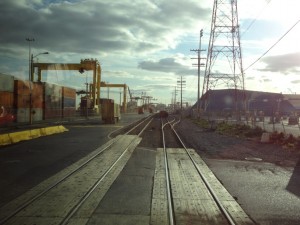
The bus tour allowed students and candidates to learn about the Port and its associated intricacies.
- The strategies employed at a container terminal and how they plan the loading and stowage of containers on board container ships.
- The role and responsibilities of freight forwarding.
- The functions of a conventional marine terminal and the vocabulary used in conventional shipping commerce.
Filed under: News, Transportation & Logistics
Tags: matt-refghi, peter-raimondo
